Wilson Electronics 276215 DUAL-BAND CHANNELIZED SIGNAL BOOSTER User Manual
Wilson Electronics, LLC DUAL-BAND CHANNELIZED SIGNAL BOOSTER Users Manual
Users Manual
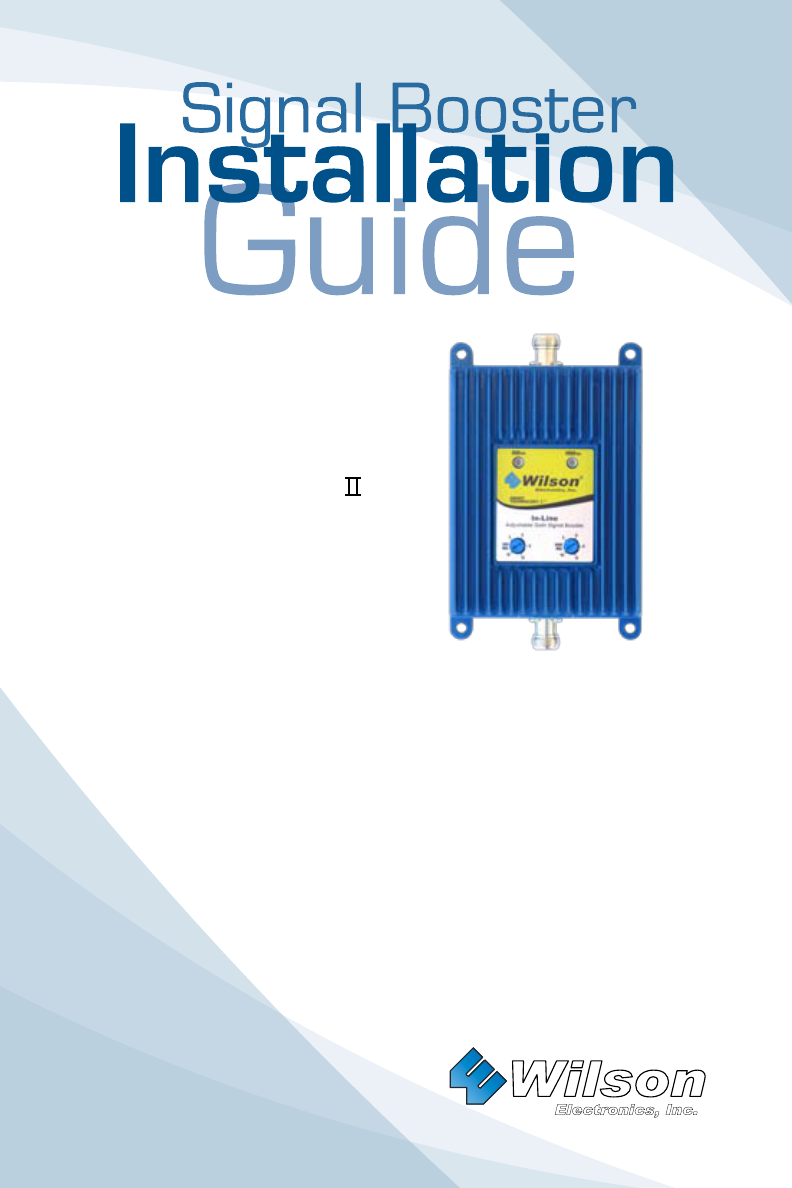
Wilson
®
Electronics, Inc.
Contents:
Quick Install Overview ..............................2
Installation Diagram ................................3
Understanding the Signal Booster Lights . . . . . . . . . . . . . . . 9
Warnings and Recommendations ....................11
Note: This manual contains important safety and operating information. Please read and
follow the instructions in this manual. Failure to do so could be hazardous and result in
damage to your Signal Booster.
In-Line
17dB Adjustable Gain
800/1900 MHz
Smart Technology ™
Signal Booster
Appearance of device and accessories may vary.
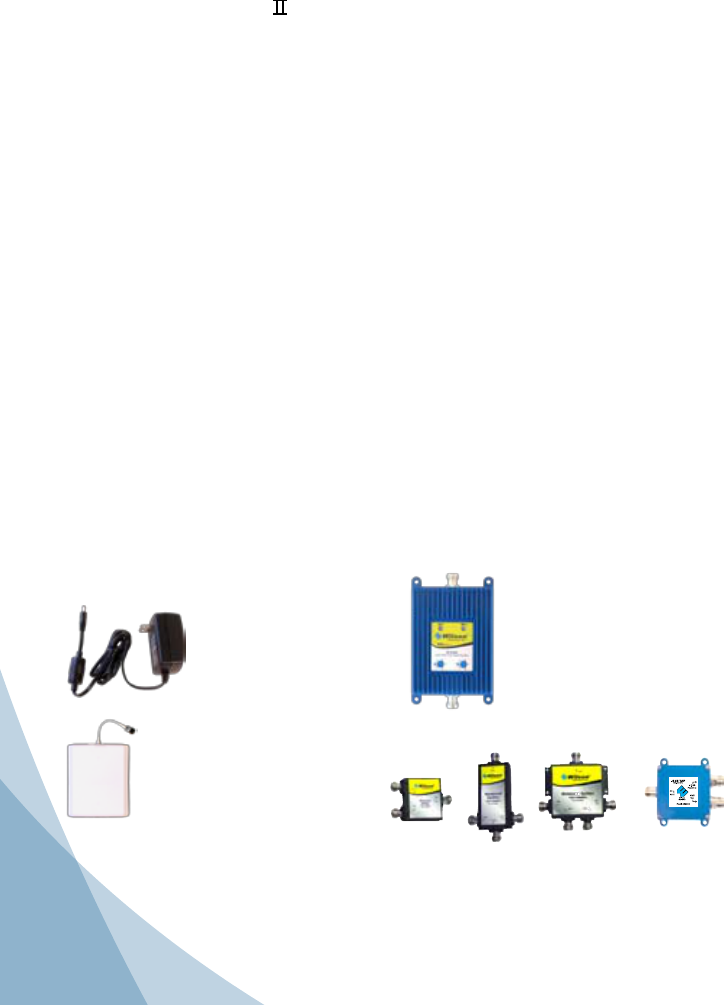
1Contact Wilson Electronics Technical Support Team with any questions at 866-294-1660
or email: tech@wilsonelectronics.com. Mon.- Fri. Hours: 7 am to 6 pm MST.
2
Installation Instructions for the Following
Wilson Signal Booster:
In-Line, 17dB Adjustable Gain 800/1900 MHz
Smart Technology
™
Signal Booster
Model # 276215 FCC ID: PWO276215 IC: 4726A-276215
The term “IC” before the radio certification number only signifies that Industry Canada
technical specifications were met.
How it Works
Wilson Electronics Signal Boosters are bi-directional devices that deliver
service levels consistent with what would be expected in areas of high cell
network coverage. They amplify a weak or shadowed signal in mobile,
marine and in-building applications. When using a Wilson Electronics
Signal Booster in conjunction with Wilson Electronics antennas, the
Outside Antenna will collect the cell tower signal and send it through
the cable to the Signal Booster. The signal is then amplified and re-
transmitted through the Inside Antenna into the room. Cell phones and
cellular data cards in that area then communicate with the improved
signal. When a cell phone or cellular device transmits, the signal is
received by the Inside Antenna, amplified by the Signal Booster and
broadcasted back to the cell tower through the Outside Antenna.
The In-Line Signal Booster (806215) is designed to offset cable and
splitter/tap loss for in-building installations. It should be used on the Inside
Antenna side of a Wilson Electronics In-Building Signal Booster such as
the AG Pro 75.
Inside this Package
In-Line
Signal Booster
(806215)
AC/DC
Power
Supply
To purchase, call Wilson Electronics Sales Department at: 800-204-4104
Indoor Antenna Option Splitter Options Tap Option
Wide-Band Panel Antenna
700-2700MHz (301135 50 ohm,
301155 75 ohm, 304451 50 ohm,
304452, 304453, 304471 75 ohm,
304472, 304473)
Note: Kits may contain different accessories
2-Way (859957)
3-Way (859980)
4-Way (859981) (859907)
Appearance of device and accessories may vary.
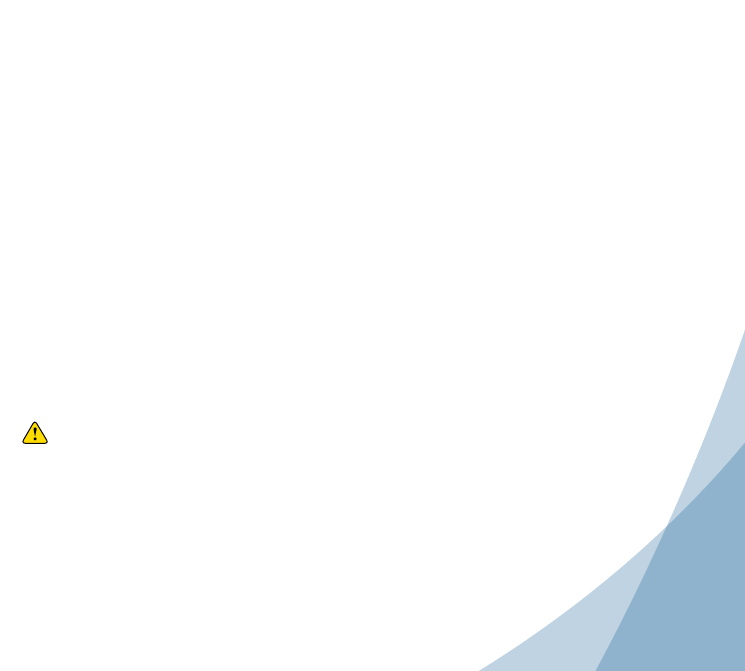
1
2
Contact Wilson Electronics Technical Support Team with any questions at 866-294-1660
or email: tech@wilsonelectronics.com. Mon.- Fri. Hours: 7 am to 6 pm MST.
1. Install In-Building Signal Booster (such as the AG Pro 75 sold separately).
Use the installation guide for the model you purchased to install.
2. Select a location to install the In-Line Signal Booster that is away from
excessive heat, direct sunlight, moisture and has proper ventilation. Do not
place the Signal Booster in an air-tight enclosure.
3. The In-Line Signal Booster should be placed where it can make up for
installation gain loss due to cable, taps or splitters. Optimal location is near
or directly connected to the Inside Antenna.
4. a) Connect a cable to the in-building Signal Booster at the connector
labeled “Inside Antenna.”
b) Run the cable to the In-Line Signal Booster, attach to the connector
labeled “Outside Antenna.”
c) From the In-Line Signal Booster connector marked “Inside Antenna” run
a cable to the Inside Antenna.
For more information on running cable
(see
diagram on pages 3 & 4).
5. Before powering up the
In-Line
Signal Booster, verify that all cables
are connected and check that all connections are tight. Note: Be careful
when plugging the connectors in so as not to bend the center pins on
the connectors (
see page 7).
6. The
In-Line
Signal Booster has been packaged with the gain control
knobs adjusted to the highest gain position. If one or both of the lights
are not green (see pages 9 & 10).
Quick Install Overview
See Installation Diagram on page 3. Contact Wilson Electronics Technical
Support Team with any questions at 866-294-1660.
Warning: Connecting the Signal Booster directly to a cell
phone with use of an adapter may damage the cell
phone and/or the Signal Booster.
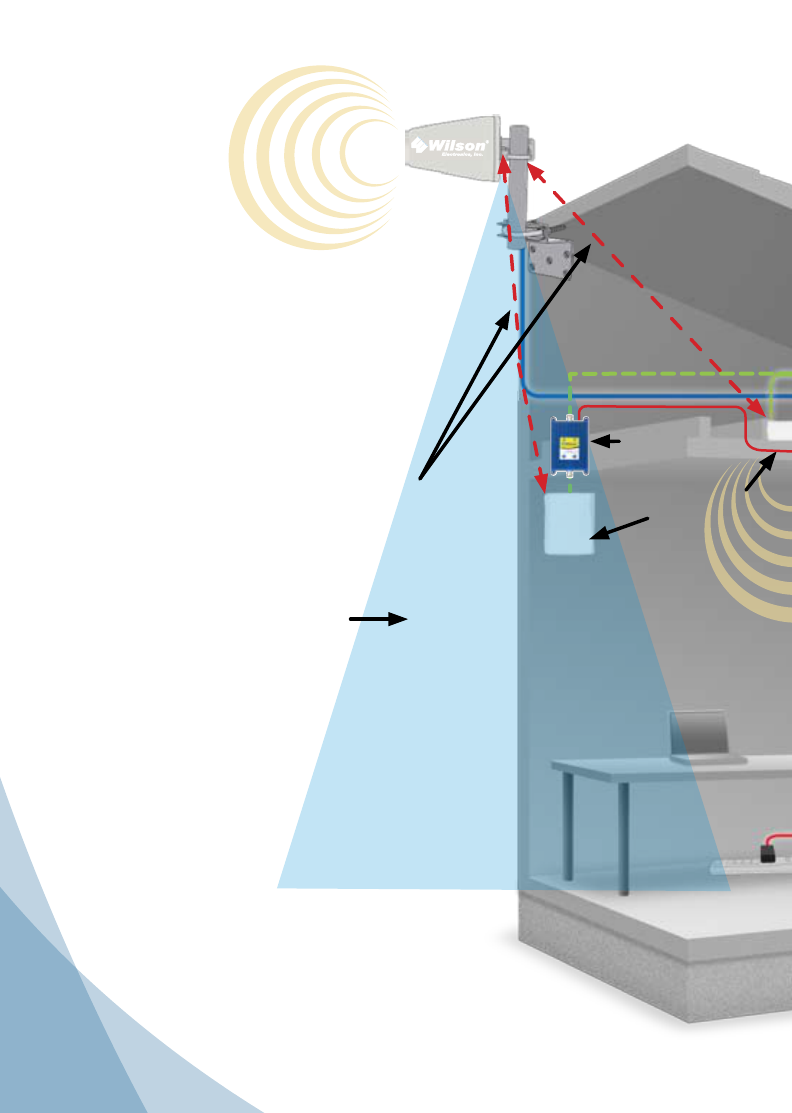
3Contact Wilson Electronics Technical Support Team with any questions at 866-294-1660
or email: tech@wilsonelectronics.com. Mon.- Fri. Hours: 7 am to 6 pm MST.
4
Typical Installation
Outside
Antenna
Inside Antenna
Potential
In-Line (806215)
location
Installation Diagram
Inside Antenna
Preferred Method: Place the Inside
Antenna in the ceiling facing down for
the best coverage.
Note: A Lightning Surge Protector is
recommended for all building installations
(sold separately). Make sure the protector
is installed in line between the Outside
Antenna and the Signal Booster.
(Optional
second
antenna for
additional
coverage).
Null Zone: The area under
the Outside Antenna, where
the Outside Antenna radiates
the least.
Note: The Inside Antenna may be
mounted on the wall directly under
the Outside Antenna, in the null zone,
if 20 feet of vertical separation can
be maintained.
Note: Do not install the In-Line
without an In-Building Signal Booster
between the Outside Antenna and
In-Line.
Note: Install the In-Line close as
possible to Inside Antenna for optimal
performance.
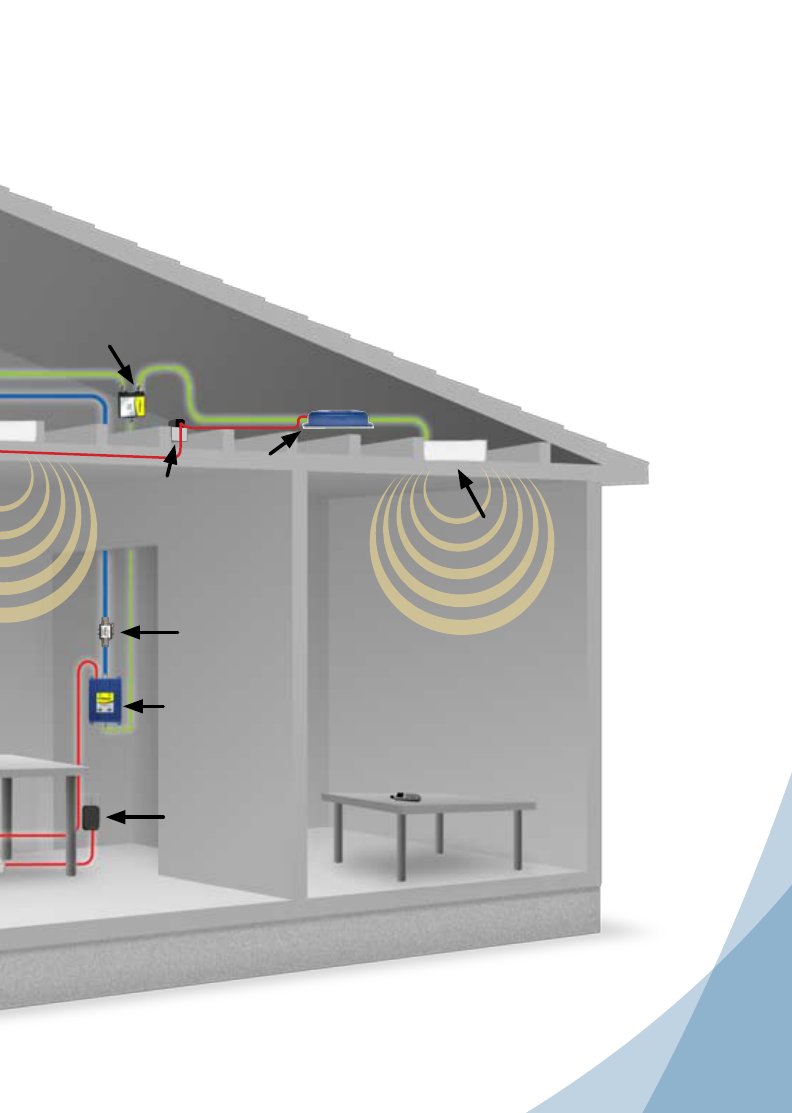
3
4
Contact Wilson Electronics Technical Support Team with any questions at 866-294-1660
or email: tech@wilsonelectronics.com. Mon.- Fri. Hours: 7 am to 6 pm MST.
Before Getting Started
This guide will help you properly install your Wilson Electronics Signal
Booster. It is important to read through all of the installation steps
for your particular application prior to installing any equipment.
Read through the instructions, visualize where all the equipment will
need to be installed and do a soft installation before mounting any
equipment.
Contact Wilson Electronics Technical Support with any questions
at: 866-294-1660.
Power
Supply
Power
Supply
Signal
Booster
Lightning
Surge Protector
(recommended)
Splitter
(if using multiple
inside antennas)
Potential
In-Line (806215)
location
(Optional
third antenna
for additional
coverage).
Inside Antenna

5Contact Wilson Electronics Technical Support Team with any questions at 866-294-1660
or email: tech@wilsonelectronics.com. Mon.- Fri. Hours: 7 am to 6 pm MST.
6
Reasons for Using a In-Line Signal Booster with
In-Building Installations
Covering multiple rooms or even floors of a building can be challenging
as each is a different size and shape. Balancing the signal coverage can
require multiple attenuators, cables, taps and splitters. All of these can
decrease your system gain and coverage. Reasons to install an In-Line
Signal Booster include:
Cable loss – Long runs of cable from the Inside Antenna to the main 1.
Signal Booster may have significant loss or require expensive low-loss
cable.
Splitter loss – When multiple rooms must be evenly covered, a splitter 2.
evenly divides the signal for separate Inside Antennas. Each division
reduces system gain and inside coverage area.
Tap loss – Taps pass the signal with low attenuation out one port and 3.
pass the signal with high attenuation port continues on to another
location possibly with more splitters and taps downstream. The
attenuation port typically runs directly to an Inside Antenna.
Increased system dynamic range – A user who gets too near an Inside 4.
Antenna can lower the gain and coverage area for all other users. The
In-Line Signal Booster adds dynamic range to the in-building installation
and reduces use of the main Signal Booster automatic gain control.
The In-Line Signal Booster overcomes the losses associated with large
in-building installations. The Signal Booster recovers inside coverage area
that is normally lost due to cable, splitter and tap loss. By installing the
Signal Booster near an Inside Antenna, uplink noise figure is minimized
and downlink power is maximized. Additionally, the In-Line Signal Booster
enhances performance of the main Signal Booster by increasing the system
gain and input signal dynamic range. The variable gain knobs on the In-Line
allow for simple, quick signal level balancing and installation.
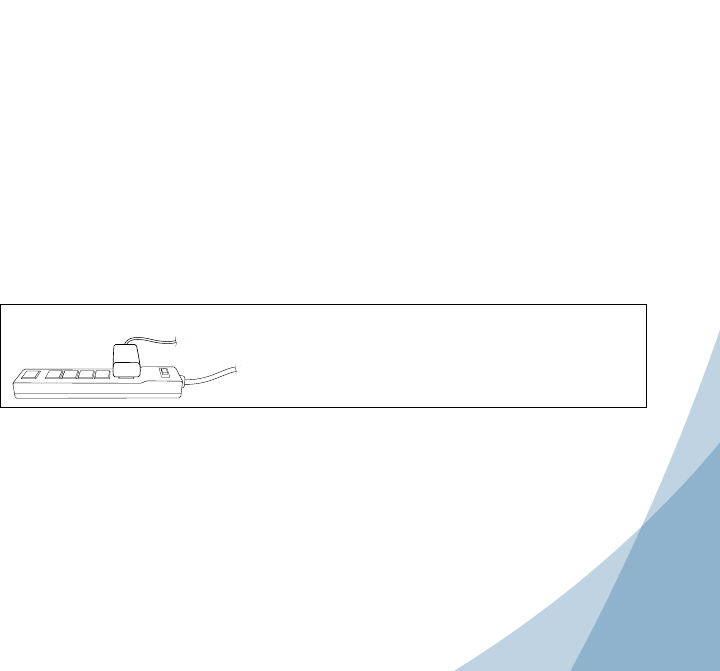
5
6
Contact Wilson Electronics Technical Support Team with any questions at 866-294-1660
or email: tech@wilsonelectronics.com. Mon.- Fri. Hours: 7 am to 6 pm MST.
Installing a Wilson Electronics In-Line
Signal Booster
Select a location to install the In-Line Signal Booster that is away from
excessive heat, direct sunlight, moisture and has proper ventilation. Do not
place the Signal Booster in an air-tight enclosure.
Recommended installation
locations for In-Line Signal Booster are:
On a shelf •
In a closet •
Near a power outlet•
Near the Inside Antenna•
Where there is more than 5dB loss between•
In-Building Signal Booster and Inside Antenna
Note: It is important to have adequate air ventilation. Maintain at least 6
inches of clearance from surrounding objects.
The In-Line should be placed where it can make up for installation gain loss
due to cable, taps or splitters. Optimal location is near or directly connected to
the Inside Antenna.
Note:
For distances of 20 feet or more, use Wilson low loss cable to prevent
significant signal loss or
contact Wilson Electronics Technical
Support Team for assistance: 866-294-1660.
Note: Be careful when plugging the connector in so as not to damage
the center pins on the connectors.
IMPORTANT NOTICE
It is very important to power your Signal Booster using a •
surge protected AC Power Strip with at least a 1000 Joule
rating.
Failure to do this will void your warranty in the • event of a
power surge or lightning strike.

7Contact Wilson Electronics Technical Support Team with any questions at 866-294-1660
or email: tech@wilsonelectronics.com. Mon.- Fri. Hours: 7 am to 6 pm MST.
8
Powering up a Wilson Electronics In-Line
Signal Booster
1. Never point the front of a Directional Outside Antenna toward the
Inside Antenna. See Figures 1 & 2 on page 8.
2. Run the antenna cable from the In-Building “Inside Antenna” connector
to the In-Line Signal Booster “Outside Antenna” connector and attach
to both connectors. Run the Inside Antenna cable to the In-Line Signal
Booster and attach it to the connector labeled “Inside Antenna” on the
In-Line Signal Booster.
For more information on running cable
(see page
3 & 4).
3. Plug the 6-volt power supply into the Signal Booster input marked “6V
DC” (carefully, to avoid damaging the center pin) and then into a surge
protected AC Power Strip with at least a 1000 Joule rating.
4. If the Signal Booster does not have a green light(s), please see pages
9 & 10.
5. If you know that only one frequency band (800 or 1900) is available in
your coverage area (or going to be used), reduce the gain control on
the frequency band that is NOT in use to the lowest setting. This will
reduce the power consumption of the Signal Booster.
6. Using multiple Signal Boosters other than the In-Line in one
installation could cause interference to the cell tower.
7. Contact Wilson Electronics Technical Support Team with any questions
at 866-294-1660 or email tech@wilsonelectronics.com. Technical
Support hours are Mon.- Fri. 7 am to 6 pm MST.
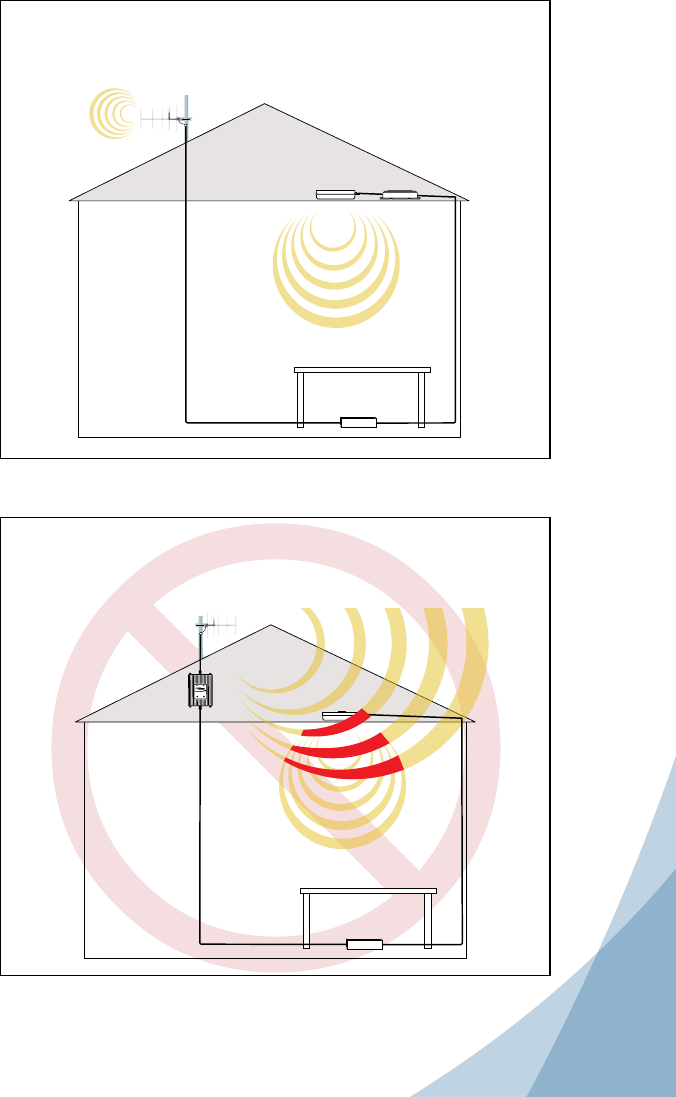
7
8
Contact Wilson Electronics Technical Support Team with any questions at 866-294-1660
or email: tech@wilsonelectronics.com. Mon.- Fri. Hours: 7 am to 6 pm MST.
Signal Booster
Inside Panel
Antenna
Figure 2
Point antennas away from each other
Signal Booster
Outdoor
Antenna Inside Panel
Antenna In-Line
(806215)
Figure 1
CORRECT INSTALLATION
We do not recommend 806215
right on Outside Antenna
INCORRECT INSTALLATION
Outdoor
Antenna
Not recommended
placement for
In-Line (806215)
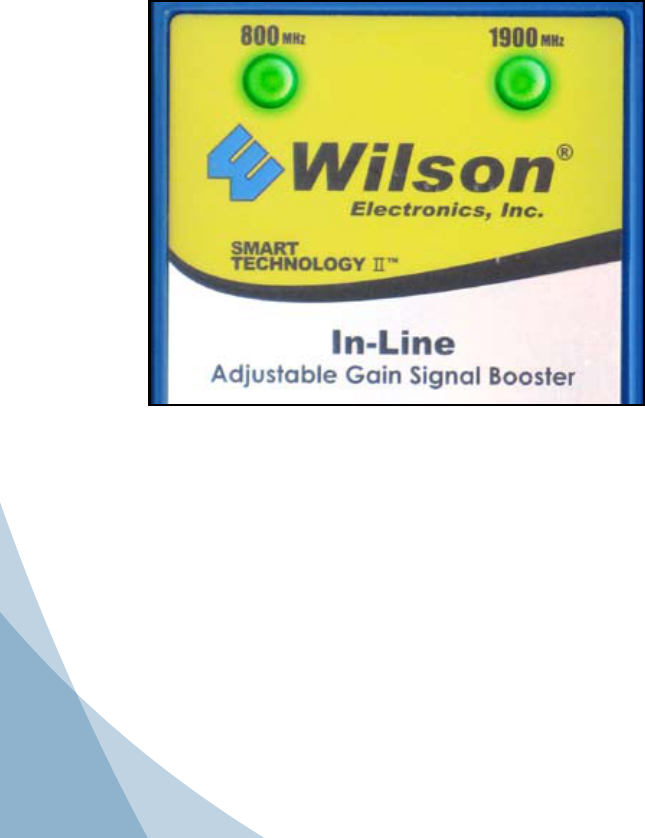
9Contact Wilson Electronics Technical Support Team with any questions at 866-294-1660
or email: tech@wilsonelectronics.com. Mon.- Fri. Hours: 7 am to 6 pm MST.
10
During installation mode the Signal Booster is resetting itself very quickly
to aid the installer. The Signal Booster is equipped with two indicator
lights, one for the 800 MHz band and the other for the 1900 MHz
band. For the first 15 minutes that the Signal Booster is plugged in, it is
programed for a test and alignment period. During this time, both lights
will do one of the following 3 things:
1. BLINKING GREEN
If the Signal Booster is blinking green, the Signal Booster is operating
properly. If you are happy with the coverage area in your building, then
you are done. Blinking will stop after the 15 minute installation period.
Understanding the Signal Booster Lights and
Troubleshooting
Note: If after the initial 15 minutes you are not done with the
installation, the Signal Booster can be reset and enter installation
mode again by disconnecting and reconnecting the power supply
from the Signal Booster.

9
10
Contact Wilson Electronics Technical Support Team with any questions at 866-294-1660
or email: tech@wilsonelectronics.com. Mon.- Fri. Hours: 7 am to 6 pm MST.
2. SOLID RED
If either of the two lights on the Signal Booster are solid red, this
indicates that the Signal Booster has shut down on that frequency
to prevent an oscillation (feedback). First, make sure that all the
connections are tight. Then reduce the gain of the Signal Booster
in small increments by rotating the gain control, counter clockwise,
waiting 5 seconds between each adjustment for the Signal Booster
to reset. Continue this adjustment until the light turns blinking or
solid green. When you are turning down the gain, you are reducing
the inside coverage area. If the amount of coverage area is
sufficient for your needs and the light is green the installation is
complete. If the coverage area is not large enough, it is necessary
to increase the separation distance of the antennas by moving them
horizontally or vertically farther apart, or both. Then increase the
gain until the red light comes on, and then slightly keep decreasing
the gain until the green or blinking green light appears. If after
separating the antennas your coverage area is still too small,
contact Wilson Electronics Technical Support Team for assistance:
866-294-1660.
If your installation takes longer than 15 minutes, it is possible to re-
enter the installation mode by disconnecting and reconnecting the
power supply from the Signal Booster.
3. SOLID GREEN
The indicator lights on the Signal Booster will be a solid green after
the first 15 minute installation period, if the unit is powered up and
working properly.
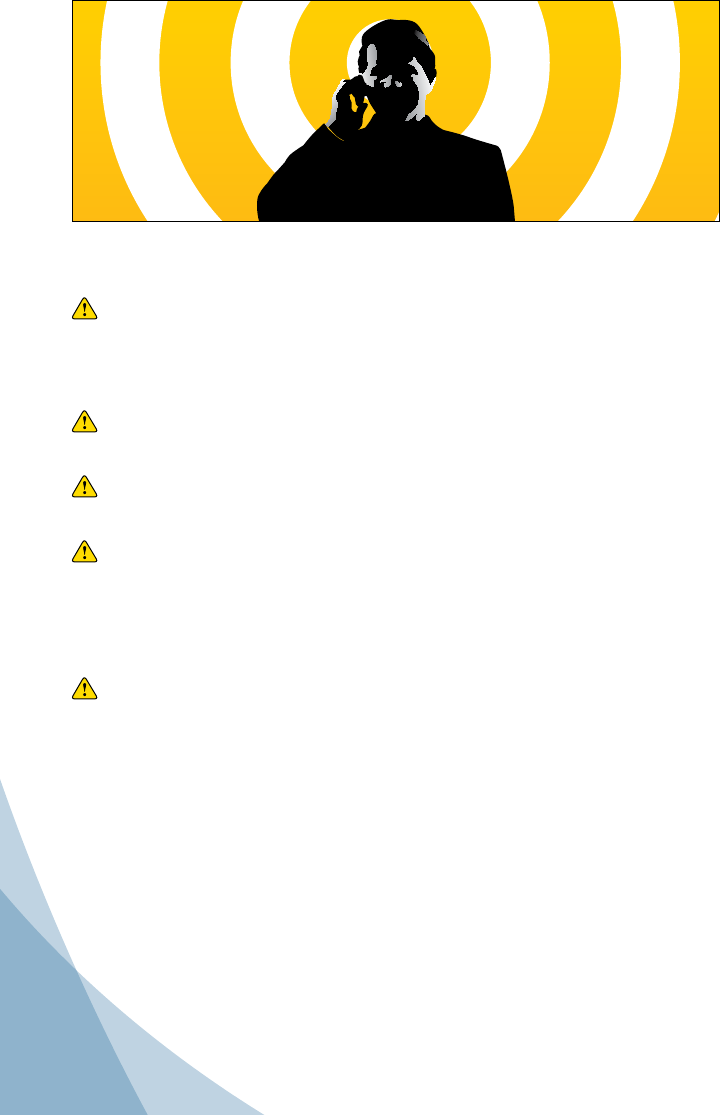
11Contact Wilson Electronics Technical Support Team with any questions at 866-294-1660
or email: tech@wilsonelectronics.com. Mon.- Fri. Hours: 7 am to 6 pm MST.
12
Warnings and Recommendations
Warning: The Directional Antenna must always be located so the
back or side points to the Inside Antenna. Never point the
front of the Outside Antenna toward the Inside Antenna –
this is to prevent oscillation.
Warning: Connecting the Signal Booster directly to the cell phone with
use of an adapter will damage the cell phone.
Warning: Use only the power supply provided. Use of a non-Wilson
Electronics product may damage your equipment.
Warning: RF Safety: FCC regulations require that the Inside
Antenna used with this Signal Booster be listed on page
1 of this installation guide. Use of other antennas is not
permitted. The antenna must be located 8 inches or more
from all persons.
Warning: Verify that both the Outside Antenna and the Inside
Antenna are connected to the Signal Booster before
powering up the Signal Booster.
Recommendation: Lightning Surge Protection is recommended for all
in-building installations.
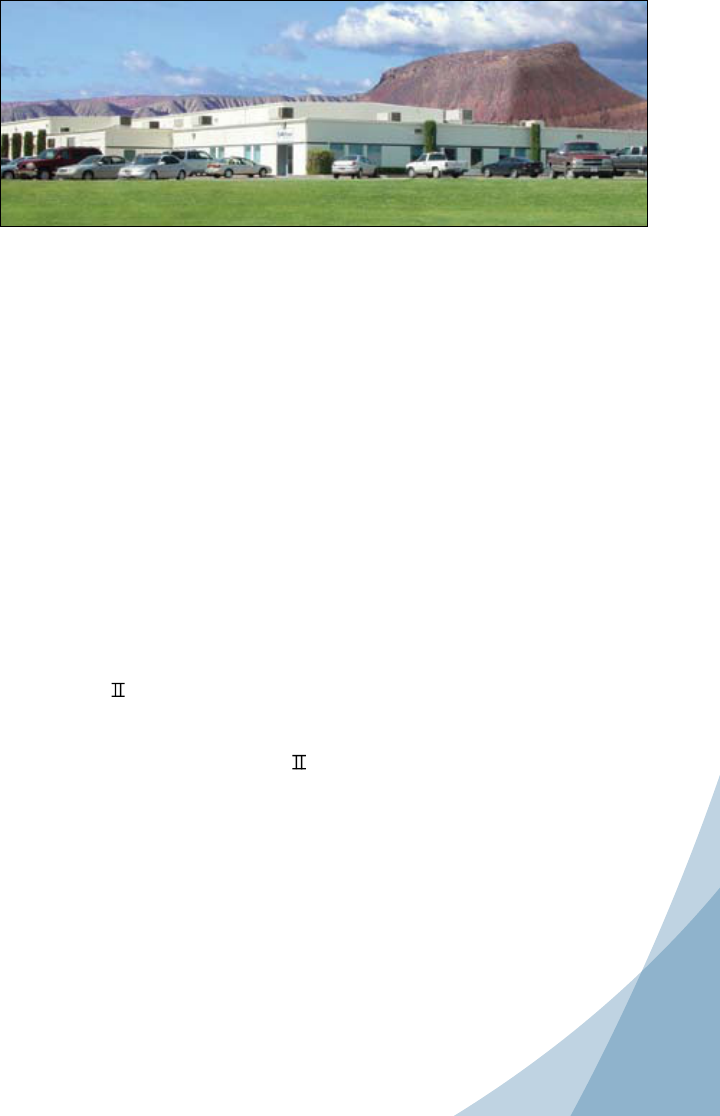
11
12
Contact Wilson Electronics Technical Support Team with any questions at 866-294-1660
or email: tech@wilsonelectronics.com. Mon.- Fri. Hours: 7 am to 6 pm MST.
About Wilson Electronics
Wilson Electronics, Inc. has been a leader in the wireless
communications industry for over 40 years. The company
designs and manufactures Signal Boosters, antennas and related
components that significantly improve cellular phone signal reception
and transmission in a wide variety of applications, both mobile
(vehicle, RV, marine) and in-building (home, office, M2M).
With extensive experience in antenna and Signal Booster research
and design, the company’s engineering team uses a state-of-the-
art testing laboratory, including an anechoic chamber and network
analyzers, to fine-tune antenna designs and performance. For
its Signal Boosters, Wilson Electronics uses a double electrically
insulated RF enclosure and cell tower simulators for compliance
testing.
Wilson Electronics Signal Boosters feature patented Smart
Technology ™ that enables them to automatically adjust their power
based on cell tower requirements. By detecting and preventing
oscillation (feedback), signal overload and interference with other
users, these Smart Technology ™ Signal Boosters improve network
cell phone areas without compromising carrier systems.
All products are engineered and assembled in the company’s
55,000-square-foot headquarters in St. George, Utah. Wilson
Electronics has product dealers in all 50 states as well as in countries
around the world.
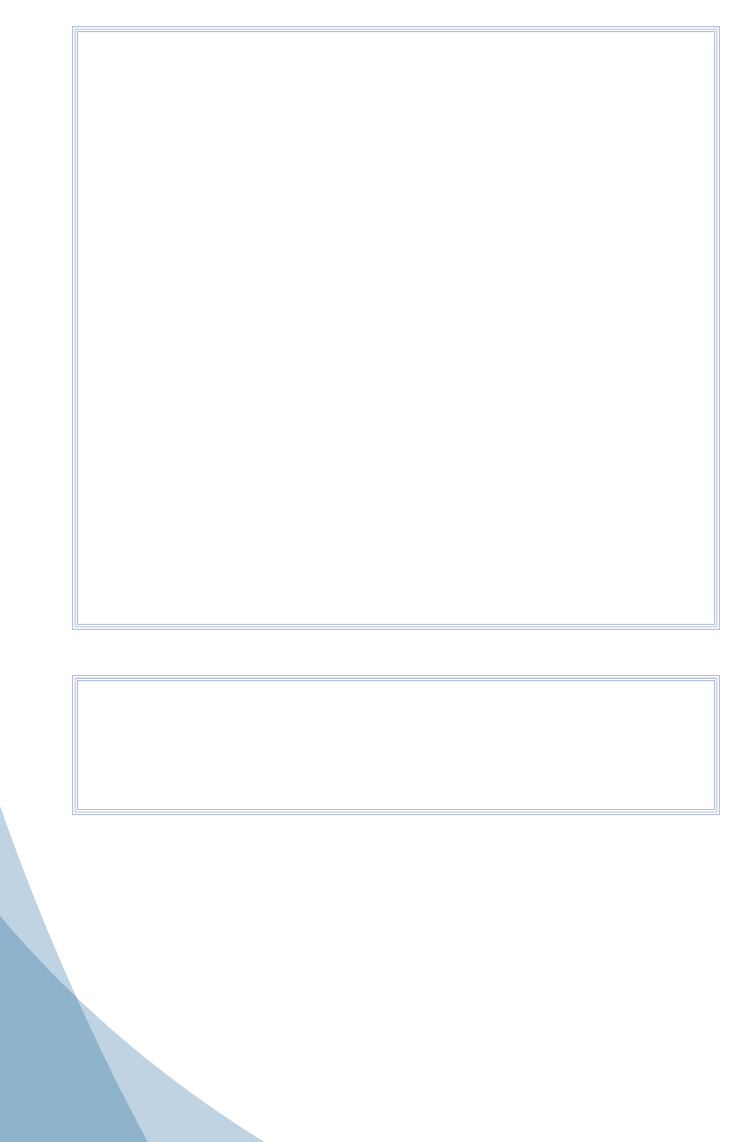
13Contact Wilson Electronics Technical Support Team with any questions at 866-294-1660
or email: tech@wilsonelectronics.com. Mon.- Fri. Hours: 7 am to 6 pm MST.
14
30-Day Money-Back Guarantee
All Wilson Electronics products are protected by Wilson Electronics 30-day
money-back guarantee. If for any reason the performance of any product is not
acceptable, simply return the product directly to the reseller with a dated proof of
purchase.
1-Year Warranty
Wilson Electronics Signal Boosters are warranted for one (1) year against
defects in workmanship and/or materials. Warranty cases may be resolved by
returning the product directly to the reseller with a dated proof of purchase.
Signal Boosters may also be returned directly to the manufacturer at the
consumer’s expense, with a dated proof of purchase and a Returned Material
Authorization (RMA) number supplied by Wilson Electronics. Wilson Electronics
shall, at its option, either repair or replace the product. Wilson Electronics
will pay for delivery of the repaired or replaced product back to the original
consumer if located within the continental U.S.
This warranty does not apply to any Signal Booster determined by Wilson
Electronics to have been subjected to misuse, abuse, neglect, or mishandling
that alters or damages physical or electronic properties.
Failure to use a surge protected AC Power Strip with at least a 1000 Joule rating
will void your warranty.
RMA numbers may be obtained by phoning Technical Support at 866-294-1660.
Disclaimer : The information provided by Wilson Electronics, Inc. is
believed to be complete and accurate. However, no responsibility is assumed
by Wilson Electronics, Inc. for any business or personal losses arising from its
use, or for any infringements of patents or other rights of third parties that may
result from its use.
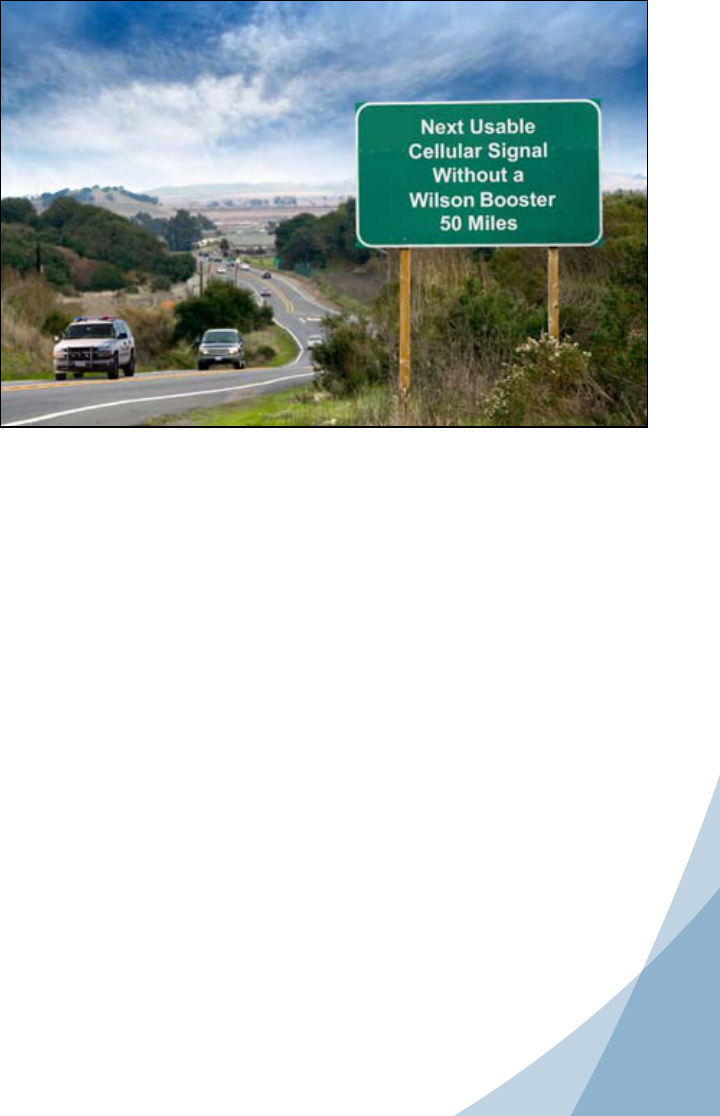
13
14
Contact Wilson Electronics Technical Support Team with any questions at 866-294-1660
or email: tech@wilsonelectronics.com. Mon.- Fri. Hours: 7 am to 6 pm MST.
This device complies with Part 15 of FCC rules. The transaction is subject to two
conditions: (1) This device may not cause harmful interference, and (2) this device
must accept any interference received, including interference that may cause
undesired operation. Changes or modifications not expressly approved by Wilson
Electronics could void the authority to operate this equipment.
One or more of the following U.S. Patent numbers may apply to the Signal Booster
in this product – D596,614; D596,615; D563,381;7,729,669; 7,486,929; 7,729,656;
7,409,186; 7,783,318; 7,684,838; 12,714,994.
Copyright © 2012 Wilson Electronics, Inc. All rights reserved.
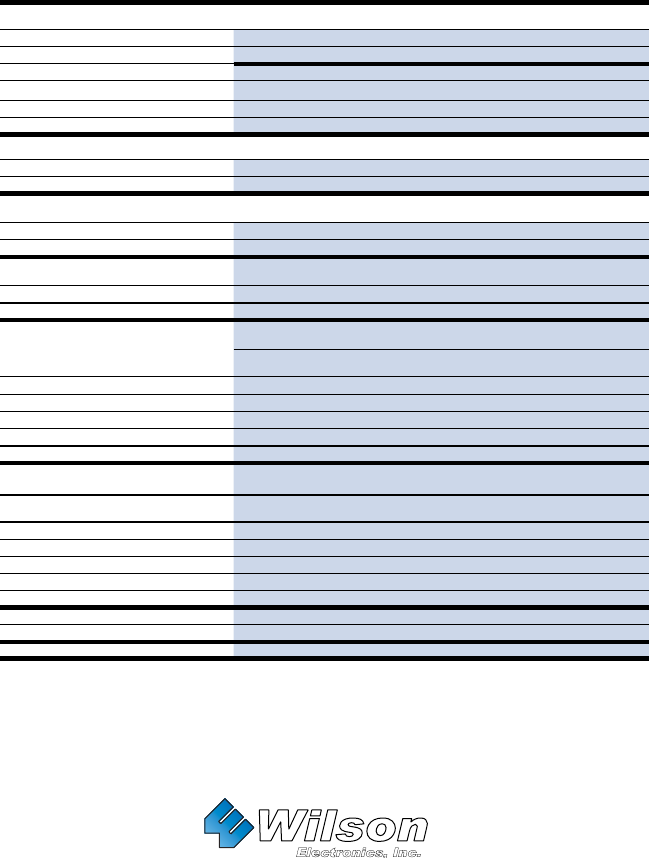
In-Line 17 dB Specifications
Model Number 276215
Antenna connectors N-Female
Antenna impedance 50 ohms
Dimensions 5.7 x 4.2 x 1.5 inch (14.0 x 10.8 x 3.9 cm)
Weight 1.27 lbs (0.544 kg)
Frequency 824-894 MHz / 1850-1990 MHz
1Passband Gain (nominal)
800 MHz uplink / downlink 17 dB typical, 18 dB max / 19 dB typical, 21 dB max
1900 MHz uplink / downlink 16 dB typical, 18 dB max / 18 dB typical, 21 dB max
220 dB Bandwidth (nominal) Uplink Downlink
800 MHz 26 MHz typical, 29 MHz maximum 29 MHz typical, 32 MHz max
1900 MHz 63 MHz typical, 69 MHz maximum 63 MHz typical, 70 MHz max
Power Output 800 MHz 1900 MHz
Power output for single cell phone (uplink) -3.7 dBm -2 dBm
Power output for single received channel (downlink) 30.2 dBm 30.5 dBm
3Power output for multiple transmitted channels
(uplink) Maximum Power
The maximum power is reduced
by the number of channels: Number of channels 800 MHz 1900 MHz
2 -10.6 dBm -9.4 dBm
3 -14.1 dBm -12.9 dBm
4 -16.6 dBm -15.4 dBm
5 -18.5 dBm -17.4 dBm
6 -20.1 dBm -19.0 dBm
4Power output for multiple received channels
(downlink) Maximum Power
The maximum power is reduced
by the number of channels: Number of channels 800 MHz 1900 MHz
2 22.3 dBm 21 dBm
3 18.8 dBm 17.4 dBm
4 16.3dBm 14.9 dBm
5 14.4 dBm 13.0 dBm
6 12.8 dBm 11.4 dBm
Noise Figure (typical downlink/uplink) 3.5 dB nominal / 6 dB nominal
Isolation > 90 dB
Power Requirements 110-240 V AC, 50-60 Hz, 8 W
Notes:
1. Nominal gain is the maximum gain at any frequency in the passband.
2. Nominal bandwidth is the difference between two frequencies that are adjacent to the passband where the amplification is 20 dB lower than the passband
amplification. One of the frequencies is lower than the passband and the other is higher.
3. The Manufacturer’s rated output power of this equipment is for single carrier operation. For situations when multiple carrier signals are present, the rating
would have to be reduced by 3.5 dB, especially where the output signal is re-radiated and can cause interference to adjacent band users. This power
reduction is to be by means of input power or gain reduction and not by an attenuator at the output of the device.
4. The maximum power for 2 or more simultaneous signals will be reduced by 6 dB every time the number of signals is doubled.
3301 East Deseret Drive, St. George, UT 84790
For additional Technical Support visit www.WilsonElectronics.com
or email at: tech@wilsonelectronics.com
Phone: 866-294-1660 Local: 435-673-5021 Fax: 435-656-2432
www.twitter.com/WilsonCellular www.facebook.com/WilsonCellular
Wilson
®
Electronics, Inc.
AIG #111003_In-Line_Rev03_02.13.12